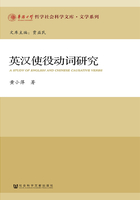
3.3 语义层面的分类——依据参与者角色分解或合成
齐曦(2007: 72)指出,关于使役意义在英语小句词汇语法层的体现,语料显示有两种类别:分解式和合成式。“分解式”英语使役结构,即“施事”“受影响者”“影响结果”三个参与者角色各自得到形式上的体现;英语中还存在一类“合成式”使役结构,其过程是由表达使役意义的动词充当,它同时体现“影响”参与者角色和过程,是两者的重合,故称为“合成式”。我们认为根据参与者角色的合成和分解来分类能概括相当多使役用法,于是,采纳这一划分将使用make类使役链接动词,如make, get/have, let的分析型致使构式和未使用make类使役链接动词但是其“施事”“受影响者”以及“影响结果”分别由相应的小句成分体现,三个参与者角色各自得到形式上的体现的结构称为“分解式使役式”(parsable/separable causative)。另一类参与者角色并不在表层一一显现,其使役过程由表达使役意义的动词充当,它同时体现“使役行为过程”和“影响结果”参与者角色,即“动作动词”和“动作结果”被概念化为一个整体,例如break同时兼有动作“打”和结果“碎”这两个概念要素。我们把这类使役构式称为“合成式使役构式”(synthetic/embedded causative),根据“分解式”“合成式”来划分,常见的使役构式如图3-1所示。
A类属于句法型使役构式,从B类到I类都属于词汇型使役构式。使役动词包括由名词、形容词、不及物动词和及物动词转化而来的动词,根据其语义可用于从B类到I类的各类词汇型使役构式。
3.3.1 句法型使役构式(分解式A)
分解式A为句法型使役构式,“施事/施动者”只是引发动作,“受影响者”是动作的实际施行者。英语make类使役链接动词,如make, get/have, let, start/stop, keep等仅表达使役过程,其使役结构是“分解式”的,“施事”“受事/主体/客体”以及“影响结果/变化”分别由相应的小句成分体现,三个参与者角色各自得到形式上的体现。其表层语法功能形式为:“S 使 O V(p)”即“NP1 CAUSE NP2 V(p)”。例如:

图3-1 各类使役构式汇总

3.3.2 致使—移动构式(caused-motion construction)(分解式B1)
“分解式B”使役结构中的及物动词,有时表示动作。例如:
(57)He kicked the ball.
但当及物动词在句子中不止表示动作,而是这些动作影响致使对象/受影响者,使致使对象产生后续行为,就构成了致使-移动构式或动结构式。致使-移动构式表达使某物位置移动,“X 致使Y沿着路径移向Z”。“影响”参与者角色由表达移动方位的介词短语体现,常译成“把……”,其使役意义由过程和结构成分互动体现。可分为几类:
1)施事直接使主体沿着路径移动,根据语义可分以下几小类。
hit类
(58)He kicked the ball into the net. (=He caused the ball to move into the net by kicking the ball. )
(59)Gleb wiped the sweat from his face. (=Gleb removed the sweat by using a cloth or your hand. )
throw类
(60)Throw the nuts to the ground(= cause the nuts to move to the ground)
(61)Put the books on the shelf(=cause the books to move onto the shelf)
push/pull类
(62)He pushed the door open. (=He caused the door to be open)
2)施事以话语等交际性行为使主体沿着路径移动
(63)Sam beckoned him into the room. (=Sam caused him to go into the room by giving him a signal. )(CCED)
3)施事使主体沿着路径移动。
(64)He loaded newspaper onto the van. (=He caused newspaper to move onto the van. )
(65)The commander marched the soldiers towards the village. (=He made the soldiers walk towards the village. )
4)施事阻止主体沿着路径移动。
(66)Mary barricaded her daughter out of the room. (=Mary made her daughter unable to go out of the room with a barricade. )
(67)Harry locked Joe into the bathroom. (=Harry put Joe in the bathroom and fastened the lock. )
5)施事协助主体沿着路径移动。
(68)John danced the puppet into the room. (=John caused the puppet to move into the room with a dancing manner. )
(69)She walked me to my car. (=She walked with me to make sure that I got there safely. )(CCED)
(70)He jumped the child up and down. (王逢鑫,1989: 91)
(71)Sam guided him through the terrain. (Goldberg, 2007: 161)
6)动词+假宾语(详见第九章9.6.2分析)
(72)We tried to laugh the girl out of that slight accident. (《21世纪大英汉词典》)
(73)Ethef washed the soap out of her eyes. (Goldberg, 2007: 155)
(74)Sam sawed/tore/hacked/ripped a piece off the block. (Goldberg, 2007: 152)
句(73)并不蕴含“Ethef washed the soap”,句(74)中“a piece”发生移动,但它们并不蕴含“Sam sawed /tore/hacked/ripped a piece”。因此说“the soap”、“a piece”是假宾语。
7)动词+宾语+into/out of 短语的句式也称into/out of致使构式,可分以下几类。
A.动词+宾语+into+NP
(75)Sam lured Bob into the room.
(76)Mary urged John into the room.
B.动词+宾语+out of +NP
(77)Sam frightened Bob out of the house. (Sam made Bob out of the house by frightening him. )
下面包含into和 out of的构式,已经偏离致使-移动构式,从语义上看,应属于动结式的一类,不妨称为into/out of致使构式,根据所用介词不同分以下两类。
7.1)动词+宾语+into+doing
(78)He frightened the child into giving his toy to him. (=He made the child give his toy to him by frightening/threatening the child. )
(79)He frightened the lady into signing the paper. (=He made the lady sign the paper by frightening/threatening the lady. )
(80)You can't fool me into doing that. (=You can't make me do that by fooling /cheating me. )
(81)They were forced into formulating an opinion.
(82)He had been coerced and terrorized into absconding. (=He had been made to abscond. )
类似的还有:
argue sb into doing sth(说服/劝使某人做某事)
starve sb into sth/doing sth(使某人挨饿以迫使其做某事)
intimidate sb into doing sth(胁迫某人做某事)
7.2)动词+宾语+out of
(83)He fooled her out of her money. (= He cheated her out of her money. )
(84)Sam frightened Bob out of the house. (=Sam made Bob out of the house by frightening him. )
(85)He talked Tom out of leaving. (=He made Tom change his idea to leave by talking to persuade him. )
杨晶等(2010: 71)基于BNC的数据,详细探究into致使构式中的主要动词槽位强烈吸引的动词;以搭配构式强度为标准,前30个动词分别是:trick, fool, coerce, force, mislead, bully, deceive, con, pressurise, provoke, pressure, cajole, blackmail, dupe, coax, delude, talk, goad, shame, brainwash, seduce, push, tempt, manipulate, inveigle, hoodwink, panic, lure, lull, dragoon。
into致使构式常与表示负面情绪的动词连用,如:frighten, intimidate, panic, scare, terrify, embarrass, shock, shame 等,或与表示狡黠的谈话方式的动词连用,如:talk, coax, cajole, charm, browbeat等。下面对into致使构式进行语义和句法分析。

“动词+宾语+into+doing sth”与“动词+宾语+to do sth”构式有何区别?为何encourage, convince, persuade, instruct 不能用于 into 致使构式?试比较:
(87)a. ∗Sam encouraged /convinced/persuaded/instructed Bob into the room.
b. Sam encouraged /convinced/persuaded/instructed Bob to go into the room.
句a中,encourage, convince, persuade, instruct这些动词后面的宾语需要做出一个认知决定,因此它们不能出现在致使-移动构式中,却可以出现在句b这样的带不定式补语的构式中。into致使构式的动词虽然表示心理状态,但往往不蕴含认知决定的存在,强调“被致使、难以逃避”。
再比较:
(88)a. He persuaded her to do it.
b. He persuaded her into doing something.
c. I forced John to resign.
d. I forced John into resigning.
句a是劝某人去做某事,句b是成功劝某人做了某事。Dixon(1991:197)认为句c的含义是“在结果达成之前经历了较长的过程”,句d可能描述一个很快实现的结果。有时也能交替使用,意义几乎没差别。例如:
(89)The robber forced him into handing over the money. (强盗逼他把钱交出来。)再如:
(90)They were tortured into confessing. (他们遭到拷打而招认。)
(91)The government was shamed into cleaning up its stock market. (政府因丧失颜面而对股票市场进行了净化。)
(92)Drunken drivers will be shocked into understanding the error of their ways. (醉驾司机将受到让他们深感震惊的惩罚来明白他们行为的错误。)
(93)The vaccines could stimulate the immune system into producing defense cells. (这疫苗会刺激免疫体系产生防御细胞。)
(94)We should not mislead ourselves into thinking that the ones we love must be like us. (我们不应误导自己去相信我们所爱的人必定像我们。)
into和out of属于动态介词,它们与动词的过去式连用表示动作的完成,与将来时态连用表示将来完成。句(90)中confessing表示“已经承认”,句(91)“cleaning up its stock market”是已经完成的动作,句(92)中shock事件一发生,被影响者势必经历“understanding the error of their ways”这一过程,句(93)和句(94)中使因事件一发生,-ing动词所指的结果随即产生,所谓一触即发,不可避免。
3.3.3 动结式(分解式B2)(详见第九章9.3和9.5)
动结式表达属性变化,参与者角色“影响”由表达属性的形容词以及表达身份的名词体现,形成“过程 +状态”的组合,产出一个过渡(完成)解读,致使状态变化,常译成“把……”,可分以下几类。
1)brush类
(95)We rub the woodwork smooth. (我们把木器擦得光滑。)
(96)She swept the floor clean. (她把地板扫得干净。)
2)put 类
(97)He pulled his belt tight. (他把皮带拉紧。)
(98)The shower got her clothes wet. (这阵雨把她的衣服弄湿了。)
(99)They struck the enemy dead. (他们把敌人致以死地/打死。)
(100)The news turned his hair white. (这消息使他的头发白了。)
这两类指通过使用某种工具或某种行为或某种事件对受动对象产生影响结果。句(97)语义解读为“He caused the belt to be tight by pulling it”。
3)name类
(101)I name this ship Aurora. (我将这艘船命名为Aurora。)
(102)They appointed him to be manager of the company. (他们任命他为公司经理。)
这类通过将一种名称赋予某物或将一种职务委任给某人,而对宾语/受影响者产生影响。
4)其他
(103)He writes his letter large. (他把字母写得很大。)
(104)She boiled the eggs hard. (她把蛋煮老了。)
(105)He ran his shoes threadbare. (他跑得鞋子都磨破了。)
3.3.4 分解式C
分解式C指“put类动词+受事+副词”构式(verb+particle),亦称“put 类动词+particle”的结构,常用:put... on, turn... off, pick... up,take... off。
如同分解式B,其参与者成分:施事、受事/客体、影响结果分别显现。例如:
(106)Mommy put her hat on. (妈咪把帽子戴上。)
(107)Daddy took his coat off. (爹地把外衣脱下。)
(108)Daddy turned the light off. (爹地把灯关了。)
(109)Mommy picked the baby up. (妈咪把婴儿抱起来。)
“Mommy put her hat on”相当于“Mommy put her hat on herself”。与分解式B相同的是,动作的施事、动作、受事和影响结果都清晰地出现在表层;但与分解式B有所不同的是,C类的使役行为不是由一个独立的及物动词表示,而是根据“客体”her后面的on herself这一“影响结果小句”(effect clause)的性质来选定的,其表达式为:“put/take/bring/throw/give(etc. )NP on/off/in/up/to NP”,选用put 或take 看herself 前面的介词是on或off,此处put类动词可以分析为动词be的使役形式,条件是be后跟表示方位的补语,其实take, turn, pick等类似动词也具有使役含义,相当于“become”or“go/come”plus locative or stative complements. (Bowerman, 1974: 164)。
“put hat on”“take coat off”与open和break是两种类似的有潜在使役关系的句子(Bowerman, 1974: 171)。“Put hat on”这个句子存在使役过程的两个部分:一个行为作用于受事;受事经历状态或位置的变化。而在“Mommy opened the box”这句中,打开(open)的行为动作和从“未开”到“开了”的状态变化捆绑为一个词。Bowerman认为孩子在习得这句时反而比前者容易,因为孩子们无须在识别时将使役过程的两部分分解开来。我们认为此结论可能只能支持open之类常用词的习得情况,而一些抽象性更强的词汇型使役用法不一定比分析型的更易习得。
3.3.5 合成式
合成式D作格动词指呈现S+Vt+O和无生主语+Vi成对用法的动词,如Mary sailed the boat. The boat sailed. (详见第十二章)。
合成式E心理类使役动词指令人担忧(worry)、令人失望(disap point)之类造成心理变化的动词(详见第四章)。
合成式F“卷入”类使役动词指以involve为代表的一类语义有共性,主要表示“卷入到某某事件或场景”的动词(详见第五章)。
合成式I双宾类指用于双宾语VNN 构式和VNpN 与格构式的动词。(详见第六章)。
合成式G 和H为认知类使役动词和其他使役动词(详见第四章)。